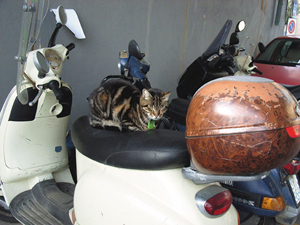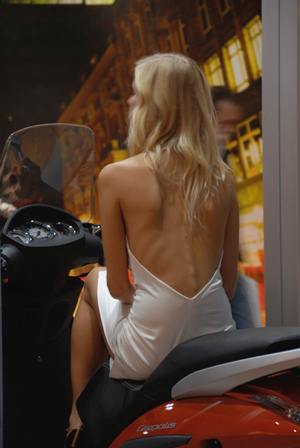
By repeated request:
The secret (and not so secret) art of packing for the big trip.
I’ve travelled with some packing experts in my time, believe me. One of them had his panniers chock-a-block with Tupperware containers, filled by his wife with balanced meals for every occasion. Another had one pannier — fortunately, only one — carefully packed with prescription drugs for every happenstance. Yet another carried all his clothing and supplies in vacuum bags with computer-generated labels. He even had a couple of spare bags prepared for dirty underwear and other clothes.
Overkill? Of course. But you’ll never know just how convenient proper packing is until you travel with someone who’s good at it. Then you’ll be helplessly furious as he (or more often she) unpacks in half the time you take, finds stuff straight away and never, ever runs out of … well, out of whatever you don’t want to run out of!
That person, by the way, is not me. I have given the matter a great deal of thought and have become quite good at the initial task (otherwise it would be a bit presumptuous of me to write this article). But I’m sure you’ve heard the old military saying that battle tactics never last past the first contact with the enemy. With me, orderly packing never lasts past the first overnight stop.
Still, here, for what they’re worth, are my recommendations.
Another packing story
Do we really need one? For those of you who are long-time loyal ARR readers, the answer is probably no. But I’ve had several requests for just this story (especially after our recent Big Trip articles) so you’ll just have to suffer through the information again — or maybe you could actually pay attention this time? Those of you who are obsessive enough to have previous packing articles photocopied and laminated for use whenever you get ready to roll, have a drink and rejoin us in three pages.
A “proper” touring ride can be as short as a week or as long as the rest of your life. The amount of gear you need will be approximately the same.
The other part of the article extends the time, with no real limit in mind. The ride could be a week or it could be a year. I’ve ridding around the world with little more than the gear mentioned here.
Bags of room
The panniers (hard or throwovers), Gearsack, Andy Strapz or Ventura bag/s, seat bag and whatever other bike luggage you have should be where you pack your gear for a real trip. The tank bag serves another function and it should come along even on short trips when you’re not carrying any other luggage. Above all, it should not serve as the overflow for the other luggage (as it has all too often done with me). It has a job to do and that job is compromised if it’s holding the tyre repair kit and the spare set of tent pegs and whatnot else.
The job of the tank bag is to make life easier and more comfortable for you on the road, and to eliminate or at least reduce the “d’oh!” factor.
Derived from Homer Simpson, the “d’oh!” factor is the realisation that you are going to miss out on something (or suffer) because you weren’t better prepared. A photo of a sight worth seeing; a note of a telephone number worth remembering; a call home to let them know you’ll be late. A dry arrival at your overnight stop. All of that and more.
In order to do that job, the tank bag must not hold too many more things. If it does it becomes too heavy and unwieldy and you end up leaving it on the bike and having it stolen (or just worrying about it). You also lose track of its contents (guilty!) and therefore find that the thing you really need isn’t there. D’oh!
One thing that should not be in your tank bag is your paperwork. Even if you religiously take it with you whenever you leave the bike, it can still be forgotten or stolen, or even rifled through by someone while someone else distracts you. One copy of your paperwork (the original) should be somewhere on your body, in an inside pocket; another (photocopied) should be tucked away in a waterproof package deep in a solid pannier.
The tank bag
Let’s start at the bottom. The first thing is a lightweight rain suit. You can buy these from bike shops all over the place and just about every importer and distributor offers one. They used to cost $100 or just a little less. Today they cost $110 or so. Thank you, Mr Howard and the GST.

Despite that price increase, a lightweight suit is well worth having. Wet hands and even wet feet are, err … bearable, but it is nice if your body stays dry in that unexpected downpour.
On top of this suit (or, more often now, the waterproof lining for my Tiger Angel Guardian suit), in a Ziploc plastic bag, I carry my mobile phone; my Road Atlas; a small notebook with a pen; some postcards; a Swiss Army knife; a paperback book; and my musician’s earplugs. The Ziploc bag means that I don’t have to worry about this stuff getting wet, even in a tropical storm.
The postcards might seem a bit odd, but it’s nice to be able to drop the kids or other family members a line from the road. Buy a batch every now and then, carry them stamped and write them while you’re enjoying a coffee or over your lunch. This gives you something to do and it’s a nice touch for the loved ones. If you don’t have any loved ones you can always write to your enemies and make them jealous. This is probably even more fun. Whoever the lucky recipient is, you’ll find that postcards are somehow much more exotic than a mobile phone call.
Another item you might like to consider for a Ziploc bag is a cheap, small digital camera — giving you the potential to capture some wonderful moments. Get one with a built-in flash and the light (or lack thereof) will not matter. Low cost and modest resolution are fine unless you’re going to use your photos professionally. If the tank bag is magnetic, try to keep the camera away from the magnets.
Loose in the tank bag I also carry a bag or stick of barley sugars. It doesn’t actually matter what kind of lollies you carry, but do carry some. They are an excellent source of instant energy hits, invaluable when you’re falling asleep in the afternoon of a long day’s ride or if you have missed a meal. Also loose is a roll-on container of sunscreen. My nose is quite red enough from port attacks without hitting it with sunburn as well. And while we’re on the subject of the sun, carry a pair of sunglasses.
In an external pocket, if there is one, I carry a small handful of change. That’s useful for tolls, a replacement packet of barley sugars, a cold drink or whatever — and I don’t have to drag my wallet out, especially if I’m wearing a rain suit! If there’s no outside pocket in the tank bag I put the change into another small Ziploc bag.
For longer trips I have a few more things that I slip into the tankbag. The first is my 350mL thermos. Full of hot coffee in winter and cold water in summer, this is a welcome source of fluid by the side of the road. And at least I know I can get decent coffee!
The next thing is a small torch, useful for all sorts of things, and not only at night. You can use it to peer into nooks, crannies and petrol tanks. Solar-powered ones are now available, and cheap.
Finally, there’s a spare pair of spectacles; you never know when you might need those and I’m blind as a bat without glasses. My sunnies double for this, since they have prescription lenses.
Even with all this extra stuff in it, the tank bag is not too heavy to carry around comfortably when sightseeing or wandering into a restaurant for lunch.
The best bag is a small, easily detachable one, possibly with a base that stays on the bike. That way you can just unclip it when you leave the bike to go into the pub, cafe or museum and you don’t have to worry about it. A magnetic bag can be useful for this as well, but beware of affecting electronic equipment or scratching the tank. It’s a bonus if the bag is an expanding one because then you can compress it to hold everything firmly.
A good sort
We will need to leave the actual luggage for another story, because there’s something more important to consider: your choice of stuff to pack. There are several ways of determining this.
One that I quite liked the sound of (until I tried it) goes like this: when you pack you also make a list of everything you’re taking. Then, when you actually use something, you put a tick against it on the list. Next time you go travelling, you take only the things that were ticked — and therefore used — on your last trip. And so on. There are variations on this like the one that involves putting little spots of paint or marker pen on things (like tools) as you use them, but they boil down to the same thing.
Of course there are some problems with this method, the main one being that you’ve usually got better things to do on a trip than be ticking off lists or dabbing paint on your tools.
My preferred system has been the old tried-and-true one which involves piling everything you know you will absolutely need onto the bed and then halving it. After you’ve halved what remains yet again, you should be somewhere near a manageable amount of luggage.
The worst method I have found is where you take your panniers or other luggage and just start loading them up with the stuff you want to take. Theoretically you have to stop when you’ve filled the panniers, but of course there is inevitably something really vital — like all your clothes, say — that’s still left to be accommodated when you’ve reached fullness. So you either scrabble everything out again and find something to leave behind or you dump the clothes into a bag and strap the bloody thing on somewhere. Not ideal, either way.
Alternatively, you reach the end of the things you think you’re going to need and there’s still room. Then it’s … Wow! Hey, I’ll take another pair of jeans and maybe a light jumper as well as the thick one and … that way lies disaster, too.
So is it hopeless? Is packing doomed never to be right?
Well, not necessarily. The trick I use these days is to follow someone else’s list.
I’ve got a little list
A friend of mine told me his list a long time ago. It’s quite liberating. His list was a bit shorter than even my shortest one; it basically consisted of “toothbrush, pair of shorts, spare T-shirt, thongs, packet of Drum and matches”. Here’s my version.
I don’t smoke, so no Drum.
To begin with, you naturally enough wear your riding gear (leathers, Draggin’ Jeans or whatever; I often wear my Tiger Angel Guardian suit, with the lining in if it’s cold), and underwear appropriate to the season plus a T-shirt under it, plus a light jumper if it’s really cold. Add waterproof touring boots, helmet and a pair of gloves — summer or winter weight, depending on the season. You also make sure that your bike’s toolkit, suitably augmented (more on that elsewhere, at another time) is in place. Then you pack:
• In summer, a spare pair of warm and waterproof gloves
• A pair of jeans or moleskins
• A pair of light, flat walking shoes (Converse, or even judo slippers)
• A pair of thongs (jandals to our New Zealand readers, flip-flops to the Americans and a complete mystery to anyone else)
• Two T-shirts
• Two pairs of underpants (I use quick-drying ones, available from travel shops)
• Two pairs of socks
• Two handkerchiefs (more practical than tissues)
• A light jumper (unless you’re already wearing one — then add a light nylon windcheater or a sweatshirt)
• Swimming costume (in summer)
• A baseball-type cap
Pack all the clothes in a plastic bag and toss in a small container of laundry detergent so you can wash them. If you’re fastidious, include another plastic bag for dirty clothes. Then add:
• A small first-aid kit (mainly bandaids, disinfectant for cuts and scrapes and treatment for upset tummy and so on; the ambulance will have bandages)
• Your wet pack containing shaving gear, toothbrush and toothpaste, nail clippers, comb, small containers of soap and shampoo and a box of matches. Never know when you might need matches
• An air gauge (can’t trust the gauges in servos)
• Tyre repair outfit; I now carry a small Tyrepliers kit
• A Leatherman tool
• Chain lube (a small spray can) if required
• A wire coat hanger, twisted together into a ball, and a tobacco tin full of bolts and nuts
• A digital camera and a spare battery for the camera plus, possibly, a spare memory card
• Don’t forget a small amount of cash as well as a credit card (or, preferably, two, in case one gets eaten by an ATM) and your rego papers
For overseas trips you will of course need your passport. Make photocopies of this, your licence, your insurance papers and your rego.
Everyone has something else that’s vital, but try to stick as closely to this list as you can. I must admit I carry a few luxuries such as a hip flask and, if there’s room, my coffee-making gear.
The contents of this list will fit reasonably comfortably into a single pannier and will have you very well equipped. If you’re on a sports bike they’ll fit into a large tail bag. That’s neat, tidy and convenient. Try to avoid carrying a backpack, except for a hydration pack; they become uncomfortable fairly quickly.
Obviously you’ll need a bit more for a camping trip. But try it this way first and see how you go.
PT
Various versions of this story have appeared all over the place, but this one has been significantly updated.
